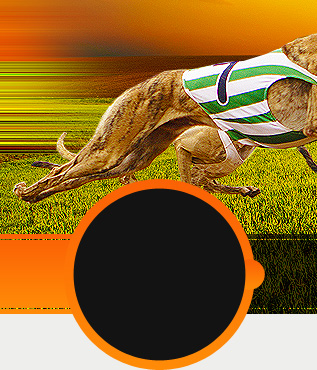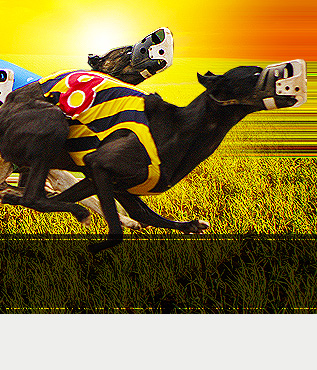Greyhound Wagering History
The origin of the greyhound is deeply rooted in ancient history. Murals and paintings of dogs strikingly similar to today's greyhound existed over 4,000 years ago. From the beginning, the greyhound was held in high regard, as evidenced by pictures etched on the walls of ancient Egyptian tombs. Pharaohs rated them first among all animals, both as pets and hunters.
The Arabs so admired the physical attributes and speed of the greyhound that it was the only dog permitted to share their tents and ride atop their camels. In early Arabian culture, the birth of a greyhound ranked second only in importance to the birth of a son. In Persia, Rome and Greece, the greyhound enjoyed similar stature and is the only canine mentioned in Holy Scripture (Proverbs 30:29-31).
It is documented that the greyhound arrived in England over 3,500 years ago. Their link with nobility was established in 1014 when King Canute enacted the Forest Laws, which stated that only noblemen could own and hunt with greyhounds. The Forest Laws were abolished in the 1500s by Queen Elizabeth I, who later initiated the first formal rules of greyhound coursing (the pursuit of hares), thus officially inaugurating the "Sport of Queens".
In the late 1800s, the greyhound was imported to America to help Midwestern farmers control the jackrabbit, a noted crop destroyer. With the advent of the greyhound in America, coursing events soon followed.
Greyhound track racing, as we know it today, began with Owen Patrick Smith's invention of a mechanical lure around 1912, which made racing around a circular track possible. The first circular track opened in 1919 in Emeryville, California. Although this track was not very successful, it paved the way for the development of the greyhound racing industry in America.
History has proven that the greyhound is an animal born to run. They were originally bred as hunting dogs because of their speed. To run is the fulfillment of a greyhound's basic instinct. Greyhounds by nature are gentle and have always had a strong relationship with humans. The breeding and training of greyhounds is an extension of the human/animal relationship established thousands of years ago.
Breeding and Raising Greyhounds
A racing greyhound begins its life after a gestation period of about 60 days, and litters generally range from five to nine pups. At birth, it will weigh from three-quarters to one and three-quarters pounds, growing to a normal size of between 65 and 75 pounds in approximately one year.
Except for size, the adult males and females of the same litter may appear identical, but sex, size and color have nothing to do with their speed.
When a pup is three months old, it is given an identifying tattoo. An owner must register a greyhound with the National Greyhound Association in Abilene, Kansas. With the registration papers, a name--with no more than 16 characters--is submitted. Unless these procedures are followed, a greyhound will not be permitted to race.
After two months, a greyhound is placed in a run to begin exercising its legs. A normal breeding farm, a pup's home for its first year, consists of stud dog quarters, brood bitch quarters, whelping kennels, puppy quarters, exercise yards and kennel runs of various sizes.
Training the Greyhounds
At the age of one year, pups (generally kept together in litters) are transferred to a training kennel. Training begins on a small schooling track where puppies are handheld so that the lure (generally a mechanical devise) is in sight at all times. As its ability progresses, the greyhound graduates to a starting box, long distances and increased fields of competition.
Once on the training track, during the first couple of schooling sessions a greyhound will establish a running pattern (inside, outside, fast-breaker, slow-breaker, pacesetter, closer, etc.) which it may use for the rest of it running life.
Greyhound Diet
A normal meal for the racing greyhound consists of two to two and one-half pounds of ground meat, vegetables and roughage, supplemented by vitamins.
Greyhound Racing Kennels
Generally between 14 and 16 months of age, sufficient training has been completed and a greyhound is placed in a racing kennel to begin qualification for a racing career.
Each kennel has a trainer who is responsible for its care. Usually each kennel is kept together, kennelled under one roof. A trainer could have up to 40 racing greyhounds in his charge and attends to all their needs. The trainer will know each greyhound by name and affectionately describes them by their individual characteristics. A greyhound, like any other good athlete, is extremely well cared for by its trainer.
Every greyhound must have a registered owner and must be from a registered kennel. Each racing kennel enters into a contract with a track to race a certain number of greyhounds during the track's season. The names of the greyhounds to be raced are given to the track, and during the season they cannot be raced at any other track, except with permission of the track holding the contract. Because of this system, a close relationship develops between a greyhound and track personnel, who show as much pride as owners and trainers.
Greyhound Race Meetings
All race meetings in the United States are regulated by state or county law, and these statutes are enforced by members and officials of the state or county racing commission.
Security at Greyhound Tracks
Two hours before post time, each greyhound is weighed. The weight of each greyhound can vary no more than one and one-half pounds from its set weight.
Greyhounds are then taken by track personnel to the lock-up area, which is in full view of the public. While in the paddock area before post time, the paddock judge checks each greyhound's tattoo and markings against identification records (Bertillon Card) prior to each race. Fifty-six identifying points of a greyhound are carefully recorded on the Bertillon Card, which assures absolute identity.
During this time, greyhounds are under strict security provided by state authorities. Urine samples are collected by the state's veterinarians and sent to laboratories to assure the absence of foreign substances. No greyhound can race while under medication.
The greyhounds are blanketed before track personnel parade them to the starting box.
These controls and procedures and the parading of the greyhounds on the track before the race--in full view of the public--ensure that the interests of the betting public are safeguarded.



